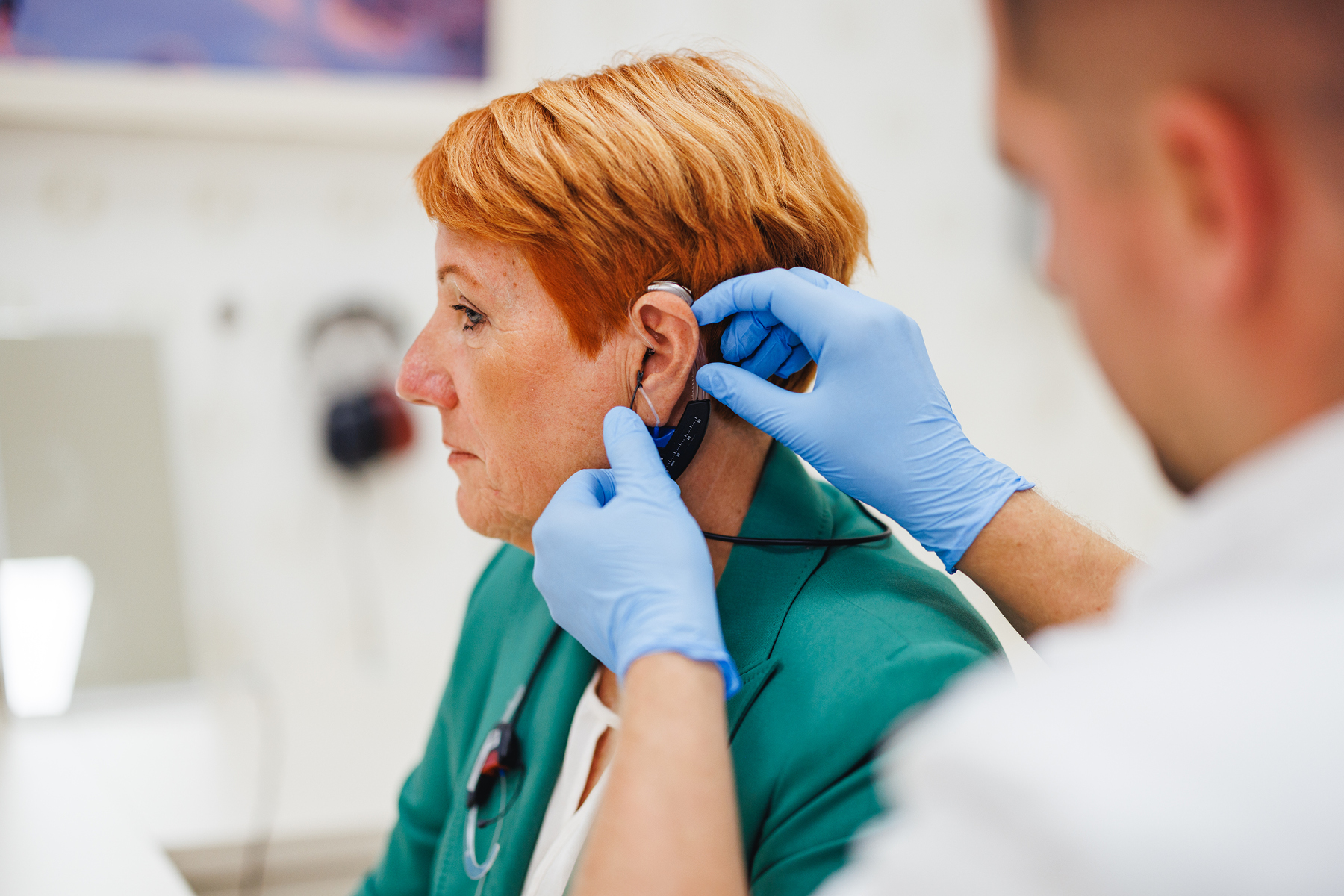This article was written by Cadan Kleinheksel, B.S., BC-HIS, a HearingLoss.com®-Certified provider at Comprehensive Ear & Hearing in Grand Haven, Michigan.

Hearing aid fittings are not all created equal. The technology inside hearing aids is impressive, but without the right verification tools, even the best devices can fall short of their potential. That’s why HearingLoss.com-Certified providers use both Real-Ear Measurement (REM) and Hearing Instrument Test (HIT) Box procedures — two complementary tools that ensure devices meet prescriptive targets and perform flawlessly in real-world conditions.
In this guide, we’ll explore what each test does, why they matter, and how using them together delivers the highest level of precision and patient satisfaction.
What Is a HIT Box and How Is It Used in Hearing Aid Fittings?
Understanding the HIT Box
A HIT Box (or more commonly referred to as a hearing aid test box, or just test box) is a specialized acoustic chamber designed to measure how hearing aids perform in a controlled environment. By removing external noise and variables, it allows for highly accurate assessments of the device’s technical specifications.
Why Hearing Instrument Testing (HIT Box) Is Important for Hearing Aid Accuracy and Consistency
HIT Box testing confirms that your device meets the manufacturer’s specifications before it ever goes into your ear. This is crucial for consistency — if the hearing aid doesn’t work as specified by the test results in the HIT Box, it can’t be expected to perform well in real life.
What the HIT Box Tests: Output, Gain, Frequency Response, and More
Inside the HIT Box, your provider can evaluate:
- Output levels: ensuring maximum sound levels are safe and comfortable
- Gain and frequency response: confirming amplification matches your prescription
- Directional microphones and noise reduction: verifying that special hearing aid features function correctly
- Battery life and performance: identifying any power-related issues

Find a Provider Who Uses Both HIT Box and REM
Not every provider follows these gold-standard tests. HearingLoss.com-Certified providers do. They validate your devices with HIT Box and personalize them with REM so you hear your best from day one.
What Is REM and Why Does It Matter?
How REM Works in a Hearing Aid Fitting
REM takes the next step by measuring how your hearing aid performs in your ear canal. A tiny probe microphone is placed alongside your hearing aid to record how sound is delivered to your eardrum in real time.
Why REM Is a Clinical Best Practice in Audiology
According to the American Academy of Audiology (AAA), REM is considered a clinical best practice — yet fewer than 3 in 10 hearing care clinics use it. This is surprising because it’s the gold standard test that ensures your hearing aids are perfectly tuned to your unique ears. Without REM, there’s no way to confirm that the amplification you’re receiving matches your exact hearing prescription.
Top Benefits of REM for Personalized, Patient-Specific Hearing Aid Adjustments
REM accounts for your ear’s unique size, shape, and acoustics, delivering:
- Precision programming based on your actual ear acoustics
- Adjustments tailored to your lifestyle and listening environments
- Ongoing comfort and clarity, from your first fitting through each follow-up adjustment
HIT Box vs. REM: Understanding the Key Differences
HIT Box vs. REM: In-Ear vs. In-Test-Chamber Evaluation
The HIT Box measures hearing aid performance in a controlled lab-like setting. REM measures performance inside your ear during real use. Both tests are essential: one validates the device, while the other personalizes it to you.

Acoustic Individualization: Device Validation (HIT Box) vs. (REM)
HIT Box testing ensures the device works as designed, according to manufacturer specifications. It’s a way to confirm that the “engine” of the hearing aid is operating correctly before it is placed in your ear, verifying amplification, output limits, and specialized features like noise reduction or directional microphones. Without this validation step, you could be wearing a device that appears fine on the outside but is underperforming or malfunctioning internally.
REM, on the other hand, ensures the hearing aid is working as needed for you. Your ear canal is like a fingerprint. Its unique size, shape, and acoustics alter how sound reaches your eardrum. By placing a small probe microphone in your ear, REM measures these effects directly, allowing your provider to fine-tune the device in real time. This makes sure the hearing aid’s performance not only aligns with manufacturer specs but also matches your specific prescription and daily listening needs. Together, HIT Box and REM bridge the gap between device-level accuracy and patient-level personalization.
Why HIT Box and REM Are Not Interchangeable and Why That Matters
Skipping either test introduces risk: A device might meet factory standards but fail to match your hearing needs, or it might be programmed perfectly for your ear but have an undetected mechanical issue such as excessive battery drain or distortion.
Why Using Both REM and HIT Box Leads to Better Hearing Aid Outcomes
How HIT Box and REM Work Together to Ensure Precision
When used together, these tools confirm that your device works as intended and is optimized for your personal hearing profile.
Supporting Manufacturer Specifications and Prescriptive Targets
HIT Box testing validates the hardware. REM ensures those specifications are translated into real-world benefit by hitting prescriptive targets for your unique ear canal acoustics.
The Real Impact on Patient Satisfaction and Long-Term Device Performance
Patients fitted using both methods report higher satisfaction, better clarity, and fewer return visits for adjustments. Over time, this leads to improved hearing health outcomes and greater device longevity.

Curious About Your Hearing Health?
The first step toward better hearing is knowing where you stand. Take our quick, free online screener to check your hearing profile today.
Do All Hearing Providers Use HIT Box and REM Testing?
What Patients Should Ask About Hearing Aid Fitting Practices
Not all providers perform both tests, and, unfortunately, skipping them can compromise your results. Ask your provider:
- “Do you verify my hearing aids with a HIT Box before fitting?”
- “Will you perform REM during my fitting to match my prescription?”
The Link Between Clinical Best Practices and Hearing Aid Outcomes

Choosing a provider committed to both HIT Box and REM testing ensures you receive care that meets the gold standard in hearing aid fitting. These two procedures form the foundation of evidence-based practice, meaning your results are not left to guesswork or “rule of thumb” programming. Performing both tests ensures that your hearing aids are delivering exactly what the manufacturer promises and exactly what you personally need.
By following these best practices, providers deliver fittings that are more precise from the start, reducing the need for repeated adjustments and improving long-term comfort and clarity. Ultimately, this approach not only protects your investment in hearing technology but also safeguards your hearing health by ensuring your aids are optimized for everyday use across a wide range of environments.
Why We Use Both REM and HIT Box and What It Says About Our Commitment to Care
Our HearingLoss.com certification reflects our commitment to the highest standard of hearing care. As a HearingLoss.com-Certified provider, our clinic upholds rigorous clinical and patient care standards. Using both REM and HIT Box testing is not optional — it’s part of our commitment to delivering precision, comfort, and long-term satisfaction in every fitting.
What Does It Mean To Be a HearingLoss.com-Certified Provider?
Nearly every industry has best practices — clearly defined, evidence-based standards that guide professionals in delivering consistent, effective, and ethical outcomes. In hearing care, many of these practices have been established by the American Academy of Audiology to ensure patients receive the highest quality of evaluation and treatment.
A HearingLoss.com-Certified clinic has proven its commitment to upholding (1) clinical best practices and (2) patient best practices, helping ensure your satisfaction and providing the resources you need to make informed decisions about your hearing health. Together, these elements help drive patient-centered care that supports your long-term hearing success.
Certified practices follow rigorous standards to ensure precise and effective hearing care:
Clinical Best Practices
- Patient consultations, hearing exams, and hearing aid fittings are thoroughly evaluated for quality and effectiveness.
- REM and HIT Box assessments are integral components to ensure accurate hearing aid programming.
- Annual visits are encouraged to monitor and address changes in patients’ hearing health proactively.
Patient Best Practices
- From the first visit to ongoing care, certified practices prioritize a seamless, supportive experience for patients.
- Certified providers empower patients to make informed decisions about their hearing health through an optimized, patient-focused care process.
This certification program was developed to bring consistency, transparency, and elevated standards to hearing aid services. It helps instill confidence that you’re receiving professional care from a provider who puts your well-being first.
Quick Answers About HIT Box and REM Testing
Why can’t HIT Box testing replace REM?
Because HIT Box testing happens in a controlled chamber, it can’t account for the acoustics of your ear canal. It verifies the hearing aid’s “blueprint,” but only REM shows how it performs in your ear in real-life listening situations.
Do I really need both tests for a good fitting?
Yes. HIT Box alone checks the device, and REM alone checks personalization. Skipping one introduces risk — you could end up with a device that works mechanically but isn’t tuned for your ears, or one that’s tuned but has hidden performance flaws.
How do HIT Box and REM together improve my results?
When combined, the tests provide a double layer of assurance: The hearing aid is first validated against manufacturer specifications (HIT Box) and then individualized for your hearing profile (REM). This dual process leads to greater accuracy, better clarity, and higher satisfaction.
Why don’t all providers use both?
Some providers skip one or both tests due to time, training, or equipment limitations. Unfortunately, this can compromise patient outcomes. Asking specifically about HIT Box and REM testing ensures you’re working with a provider who follows best practices.
What should I ask my provider before a fitting?
Ask: “Will you verify my devices in a HIT Box before fitting them?” and “Will you use REM during my fitting to confirm my prescription?” If the answer to either is no, consider whether you’re getting the highest standard of care.
Connect With HearingLoss.com
Whether you’re just beginning to notice changes in your hearing or you’ve been living with hearing loss for some time, you deserve a provider who truly listens and offers the most trusted, effective care available.
HearingLoss.com-Certified providers set the gold standard in hearing health. If you’re ready to take the next step:
- Take a quick online hearing screener.
- Search for a HearingLoss.com-Certified provider near you.
- Learn more about hearing loss, technology, and connections to total health.
Empower yourself with the care you deserve, and experience the difference of being truly heard. With a HearingLoss.com-Certified provider, you have a partner in better hearing for life.
References
- ONLINE FEATURE | Real-Ear Verification for the New Professional. (n.d.). American Academy of Audiology website: https://www.audiology.org/news-and-publications/audiology-today/articles/online-feature-real-ear-verification-for-the-new-professional/
Comprehensive Ear & Hearing in Grand Haven is dedicated to helping Michiganders hear their best and enhance their quality of life. With expert diagnostics, personalized treatment, and advanced hearing technology, the practice goes beyond simply providing hearing aids — it delivers compassionate, patient-first care. The knowledgeable team supports every step of the hearing journey, from thorough testing to customized solutions and dedicated follow-up. With a commitment to expertise and a personal touch, Comprehensive Ear & Hearing ensures patients receive the highest standard of care.


